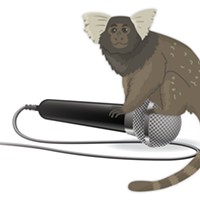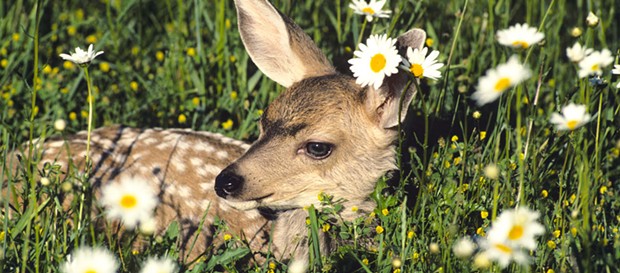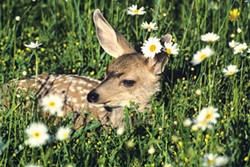
[
{
"name": "Top Stories Video Pair",
"insertPoint": "7",
"component": "17087298",
"parentWrapperClass": "fdn-ads-inline-content-block",
"requiredCountToDisplay": "1"
}
]
I recently wrote a column for the Journal about the river otter, one of the many adorable, cuddly denizens of the North Coast. "They're so cute," several readers commented, seeing the photo in the story. Then the April issue of National Geographic arrived in our mailbox with an article about our desire to bring wild animals into our beds, basements and bathrooms as pets. This helped me realize just how much we humans struggle with human/animal boundaries.
In a culture where we anthropomorphize animals — see the countless YouTube videos of dogs and cats behaving like people, cartoons in which Bambi and Scooby Doo talk, or classic books like Watership Down or Charlotte's Web — we easily forget that most animals are wild. Our lapses seem to peak with the cute ones.
Jeff Black, a faculty member at HSU's wildlife department, summarized the general principle that we should follow: "Give wild animals some space and watch them from a distance." If you encounter a marine mammal while out walking on the coastline, Lee Barnhill of the Northcoast Marine Mammal Center said, "don't touch, and keep back." The website of the River Otter Ecology Project advises us to "avoid approaching and don't harass otters if you encounter them."
Letting nature take its course is especially important this time of the year because spring is "baby season." Barnhill told me that it is common to find harbor seal and sea lion pups on beaches now. Almost always, they have been left temporarily while the mother is out foraging. Monte Merrick, co-director of the Humboldt Wildlife Care Center, used the example of fawns: "Mothers park their babies in grassy hiding spots and tell them to stay still." The mothers are often nearby. Give seemingly abandoned animals 24 hours before intervening (that is, calling the Humboldt Wildlife Care Center or the Northcoast Marine Mammal Center). Mallory Mlynarek, who has worked with injured and abandoned animals locally and nationally, noted, "Usually we do more harm than good when we think we are helping out baby animals."Good animal etiquette also includes not trimming trees this time of year. That was the first request Merrick shared with me. Of course, it finally hit me: bird nests. And, if you are closing up holes in your foundation, make sure that you are not trapping a young family. Most den sites have been well established by now, and warm, dry crawl spaces are inviting. Don't make wild animals a nuisance by inadvertently feeding them. Secure garbage cans, keep pet food, birdseed and chicken feed inaccessible in proper storage containers and protect livestock such as chickens and ducks. Don't leave cat or dog food outside at night for your pets. Each person I spoke with also made a plea to walk dogs on leashes. Whether it's a seal pup on the beach, an injured opossum you find on your daily walk, or a baby bird on the ground, there is little good that comes from the addition of a curious dog. Merrick recounted an incident in which an unleashed dog flushed out a mountain lion in Redwood National Park and, sadly, the cougar ended up euthanized. He felt that this never would have happened had the dog been leashed.
The Audubon Society offers considerable guidance about fledgling birds found on the ground. Many species of birds such as robins, scrub jays, crows and owls leave the nest and spend several days on the ground before they can fly. This is a normal and vital part of the young birds' development. These birds are usually able to walk, hop and flap, and may attempt short flights — and they're still being cared for by their parents.
If you are concerned that a nestling fell from its nest too early, you may try and return the bird to its nest. If the nest has been destroyed or is unreachable, you can substitute a strawberry basket or small box lined with tissue and suspend it from a branch near to where you believe its nest is located.
Birds have a poor sense of smell and very strong parental instincts, which means they will usually continue caring for their young, even after human contact. However, adult birds are cautious after any type of disturbance and it may take several hours before they approach the nestling. It is essential that humans (and pets) stay away.
It's important to understand that wild animals can be dangerous. Marine animals, even the irresistible river otter, are sometimes aggressive and can inflict severe bites. And injured animals, Merrick noted, can still be very dangerous. Both Merrick and Barnhill encouraged people to call them for advice, as they are happy to do phone consultations. Some 30 to 60 injured or orphaned marine mammals are rescued annually by the Northcoast Marine Mammal Center, and somewhere in the range of 900 to 1,000 animals end up at the Humboldt Wildlife Care Center. Both centers agree, however, that these halfway homes should be a last resort.
My path often crosses with wildlife here on the North Coast. I love that. But I recognize just how important it is, for them and for me, to be content to observe but not interfere.
The Northcoast Marine Mammal Center
The NMMC rescues and rehabilitates stranded, sick or injured seals, sea lions, dolphins, porpoises and whales from Mendocino to the Oregon border. The center, located in Crescent City's Beachfront Park, is also open to visitors. The hotline is 707-465-6265. www.northcoastmmc.org.
The Humboldt Wildlife Care Center
HWCC provides care for most native species of birds and small mammals, including protected and endangered wildlife. Animals that cannot be treated by HWCC are transported to other licensed rehabilitation centers. The hotline is 707-822-8839 and staffed 9 a.m. to 5 p.m. daily (9 a.m. to 7 p.m in the summer). Leave a message after hours. The HWCC services northern Mendocino County to the Oregon border and east to Trinity County. www.humwild.org.
Speaking of...
-

Kambing and Kennedy
Nov 23, 2023 -

Wildlife Emergency, Guns and Funky Wine
Sep 15, 2023 -

Zoo Animal Council Meeting Minutes
Jun 15, 2023 - More »
more from the author
-
Building Trails and Resilience
An update on the virtual Trails Summit
- Jun 11, 2020
-
Throw Like the Irish
Road bowling for beginners
- May 14, 2015
-
Thar She Blows
Whale watching on the North Coast
- Mar 19, 2015
- More »
Latest in Get Out
Readers also liked…
-
A Walk Among the Spotted Owls
- Apr 27, 2023


































